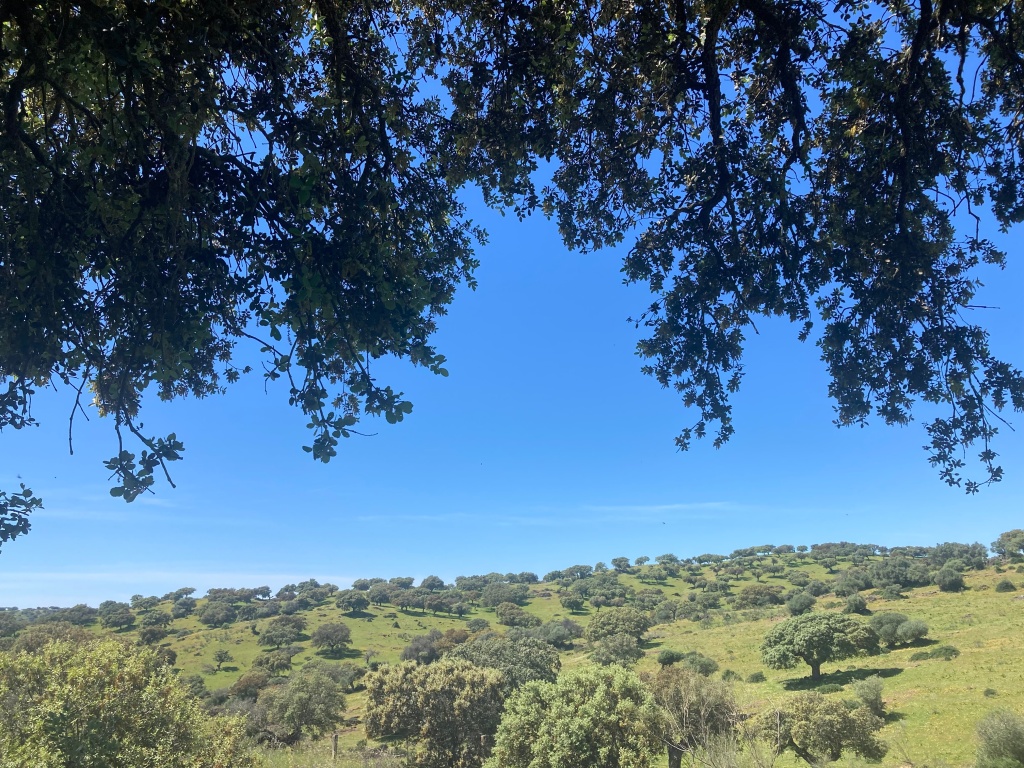
There are pools of shade in the rough dehesa, and the holm oaks hunched in galleries of strange, pathetic shapes. You and I might think of oak in vast imperial terms, but these are scrubby robles enanos which operate on a rapid turnover in the rage of an open sun. They’re nothing like our stately trees, and even their leaves are coiny and horn-spooned with a prickle at the tip like the oversized buds of an old cow’s tongue. Instead of luxurious verdancy, they’re oat green; willow green; silver grey in the shadow, trailing flowers in catkins as the sap rises for a new year. There are bees about these flowers, and later I would try the honey which was sold for a premium in a fly-filled shop. It’s thick and black as engine oil, with a flavour more like treacle than nectar.
When you lie at full length in the dried-out hayshade of these oaks, the ground around you is littered with acorns – and each one is active in the work of growing. I tried to gather a handful and found them anchored to the soil with stubborn little roots – and many of these expressed such a stubborn desire to persist that they almost recoiled from my touch, just as a clam redoubles its grip when you tease it. So there was no hearty cobble of dry seeds to blow lightly around in the dust; only a sense or a memory of barnacles thriving in dense concentration. Everything drove for growth and expansion, and it was easy to believe that taproots drilled and new leaves emerged in the time I spent lying there.
Red-and-black insects stalked around the acorns like gardeners boasting of new and outrageous achievements in the latest crop of marrows. In a crack of the upright bark nearby, a tremble of light through the leaves enabled a spider to blink all eight of his saucer-bright eyes from one side to another in a smiling Mexican wave. He wasn’t out to hunt or breed or clean his web; only to sit as the old men do in town, brown as nuts on plastic chairs with nothing to do but shift as the shade evades them.
The dehesa is a kind of open wood pasture, variously populated by black or red beef cattle with gently upcurved horns. They amble softly through the trees and lie in the shade, and some farmers work harder than others in this part of Spain. In certain places, the dehesa is grazed to the roots and the trees are bare and failing. Where new oak trees have appeared, they’re nurtured through early vulnerability with plastic guards or wooden palisades. On other properties, the trees are steadily winning over and it seems like livestock are only occasional visitors in a froth of scrub at every age and stage of development. I’d found myself in such a place, with no sign that any cow had passed nearby for many weeks or months.
And thinking of nothing much in the slowdown towards midafternoon, strange warmths began to overcome me like brandy fumes. The downy grass rose around me, and the heavy-eyed thistles too drowsy to jag or tug at my shirt. In darkness against the overhead sun, I lay beneath the wide, expanding boughs and was utterly consumed by the hang of pollen, the stroke of gossamer and the metronomic call and response of cuckoos and hoopoes on the upward-facing hill. Cowbells chimed in the distance, and vultures casted tabs of shade far down from the daylight blaze.
Then my eyes were closed, and I was conscious of being carefully and comprehensively put to sleep. The warm breeze brought a bee nearby. I smiled at him without looking, dopey as a cow in the crickle and burr of the grassheads – and if I was minded to be fanciful, I could start to assume that none of this was happening by chance. In the almost-audible creep of acorns’ growth, it seemed clear that whatever fairies we’re said to have in Scotland are clumsy, thrifty hogs against this kind of magic.
Leave a comment